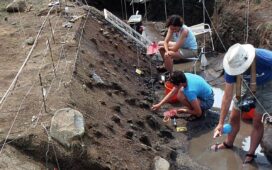Scientists have uncovered the fossil remains of a tiny feline species smaller than a house cat from an ancient cave in eastern China.
Researchers from the Chinese Academy of Sciences say the feline called Prionailurus kurteni was an extinct species of leopard cat. It was small enough to fit in the palm of one’s hand.
The species was identified from a lower jaw fragment discovered at the Hualongdong cave in eastern China’s Anhui province.
Its size is comparable to those of the smallest modern cats like the rusty-spotted P rubiginosus of South Asia and the black-footed Felis nigripes of Africa, according to a study published in the journal Annales Zoologici Fennici. P rubiginosus and Felis nigripes are estimated to have a maximum head-and-body length of 48cm and 52cm, respectively.

“This species represents the smallest known fossil member of the family Felidae to date,” the study says of the newly discovered cat.
The discovery points to a wide diversity of felines during the late Middle Pleistocene, beginning 300,000 years ago.
Cat extremes! The Sambir lion, a huge male Panthera fossilis may have weighed anything from 353 to 912 kg (around 500 kg considered more likely), making it possibly the largest cat known. Meanwhile Prionailurus kurteni was smaller than a house cat! Both from the mid Pleistocene! pic.twitter.com/vcsKV4zDAC
— Hodari Shadowalker ❄️🐆 (@HodariNundu) November 25, 2024
Fossils of P kurteni have been rarely found because their small bodies decayed quickly in the forested habitat they preferred. The latest fossil, though, was better preserved in the cave environment, scientists say.
Previous excavations at the same cave site have revealed dozens of human fossils dating to 300,000 years ago, making them some of the earliest remains of Homo sapiens in East Asia.
Inhabitants of the cave appear to have had features of both primitive and modern humans, suggesting they were ancient hominins in the process of evolution towards Homo sapiens.
“It is unclear whether these cats constituted part of the Hualongdong cave dwellers’ diet due to the absence of human butchery marks on the fossil’s jawbone,” study co-author Jiangzuo Qigao told Xinhua news agency.
The latest dig at the cave site also unearthed fossils of around 20 ancient humans and the remains of over 80 vertebrate species, including an extinct variety of pandas.
These fossils, researchers say, can help further understand the diet of these ancient humans as well as the potential threats they faced.
“These findings are important for us to reconstruct the evolution of humans,” the researchers told the South China Morning Post.















